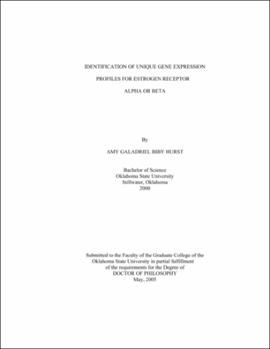| dc.description.abstract | The study of estrogen receptors are of interest due to the critical role of the estrogen signaling system in the physiology of multiple tissue systems. There are two distinct receptor types, ERalpha or ERbeta. Due to structural and functional differences, our interest lies in discovering unique independent gene expression profiles in the presence of ERalpha or ERbeta. We have examined gene regulation of the two ER isotypes within a rat embryonic fibroblast cell culture model designed to evaluate effects of each receptor protein isolated from the influence of the other; Rat1+ERalpha, Rat1+ERbeta, and precursor Rat1. Using this in vitro/ cell model, a treatment scheme involving 17beta-estradiol (E2) treatment for 24h was used to identify unique gene expression profiles. This was later followed by single dose treatments of diethylstilbestrol, 4-hydroxytamoxifen, raloxifene-HCl, or genistein for 6, 9, 12, 18, or 24 h. Treatment was followed by extraction of total RNA. To evaluate independent roles of ER, cDNA were generated from Rat1+ER?, Rat1+ER? and parental Rat1 cells following treatment with a single dose of E2 or an ethanol vehicle for 24 hours and subjected to suppression subtractive hybridization (SSH). The SSH technique demonstrated that ERalpha and ERbeta can result in differential gene expression. Genes pro-alpha-2(I) collagen, procollagen C-proteinase enhancer protein, cathepsin L, and receptor for activated protein kinase C isolated through SSH, in addition to previously studied progesterone receptor (PR), were identified for real-time quantitative polymerase chain reaction analysis to determine profile changes in the presence of different ligands over time. These data demonstrate that unique gene expression patterns exist within cells of the same genetic background, and that profile interactions are specific to ERalpha or ERbeta expression. The effects of ER isotypes as it relates to PR expression suggest that ERalpha in the presence of E2 has a major regulatory role, and that a possible cross-talk pathway exists through ERbeta mediation. The effects upon genes involved in extracellular matrix formation and general cell processes in the presence of ERalpha or ERbeta aids in understanding treatment effects and supplies impetus to better elucidate the pathway regulation involved in ER biology. | |
